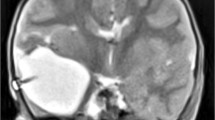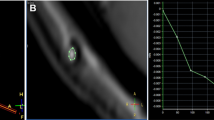Abstract
Introduction
Pediatric patients harboring shunts placed early in life are subjected to numerous radiographic studies during development of their central nervous system. Radiation is detrimental to these young patients. MRI avoids the risk of radiation but is thought more difficult due to the increased time a young patient must lie motionless during scan acquisition. Optimal radiographic interrogation would be quick, radiation-free, and allow adequate ventricular evaluation.
Methods
We queried the electronic medical records system of the senior author (SE) for the terms “hydrocephalus” and “shunt malfunction.” All patients currently younger than 18 years were included. In the last 5 years, pediatric patients have been evaluated in an office setting with a limited MRI sequence (T1 sagittal, T2 axial, T1 axial, and DWI) lasting a total of 178 s. In the event of significant motion artifact, the total sequence is abandoned and an 8-s T2 diffusion-weighted scan is performed.
Results
Forty-four patients were included in the study (20 males, average age 10.4 yrs). Eighty-eight rapid acquisition scans were obtained. Adequate ventricular evaluation was performed without sedation in every case. In each instance where there was motion, the 8-s scan provided adequate ventricular evaluation.
Conclusion
Rapid acquisition MRI scanning avoids the deleterious cumulative effects of radiation in pediatric patients and allows adequate evaluation of the ventricles without the need for sedation.



Similar content being viewed by others
References
Ashley WW Jr, McKinstry RC, Leonard JR, Smyth MD, Lee BC, Park TS (2005) Use of rapid-sequence magnetic resonance imaging for evaluation of hydrocephalus in children. J Neurosurg 103:124–130
Benz MG, Benz MW (2004) Reduction of cancer risk associated with pediatric computed tomography by the development of new technologies. Pediatrics 114:205–209
Brody AS, Frush DP, Huda W, Brent RL (2007) Radiation risk to children from computed tomography. Pediatrics 120:677–682
Chodick G, Ronckers CM, Shalev V, Ron E (2007) Excess lifetime cancer mortality risk attributable to radiation exposure from computed tomography examinations in children. Isr Med Assoc J 9:584–587
Donnelly LF (2002) Lessons from history. Pediatr Radiol 32:287–292
Frush DP, Donnelly LF, Rosen NS (2003) Computed tomography and radiation risks: what pediatric health care providers should know. Pediatrics 112:951–957
Goske MJ, Applegate KE, Boylan J, Butler PF, Callahan MJ, Coley BD, Farley S, Frush DP, Hernanz-Schulman M, Jaramillo D, Johnson ND, Kaste SC, Morrison G, Strauss KJ, Tuggle N (2008) The Image Gently campaign: working together to change practice. AJR Am J Roentgenol 190:273–274
Hall EJ (2002) Lessons we have learned from our children: cancer risks from diagnostic radiology. Pediatr Radiol 32:700–706
Hall EJ, Brenner DJ (2008) Cancer risks from diagnostic radiology. Br J Radiol 81:362–378
Iskandar BJ, Sansone JM, Medow J, Rowley HA (2004) The use of quick-brain magnetic resonance imaging in the evaluation of shunt-treated hydrocephalus. J Neurosurg 101:147–151
Miller JH, Walkiewicz T, Towbin RB, Curran JG (2010) Improved delineation of ventricular shunt catheters using fast steady-state gradient recalled-echo sequences in a rapid brain MR imaging protocol in nonsedated pediatric patients. AJNR Am J Neuroradiol 31:430–435
Missios S, Quebada PB, Forero JA, Durham SR, Pekala JS, Eskey CJ, Duhaime AC (2008) Quick-brain magnetic resonance imaging for nonhydrocephalus indications. J Neurosurg Pediatr 2:438–444
Verdun FR, Bochud F, Gundinchet F, Aroua A, Schnyder P, Meuli R (2008) Quality initiatives* radiation risk: what you should know to tell your patient. Radiographics 28:1807–1816
Author information
Authors and Affiliations
Corresponding author
Rights and permissions
About this article
Cite this article
Wait, S.D., Lingo, R., Boop, F.A. et al. Eight-second MRI scan for evaluation of shunted hydrocephalus. Childs Nerv Syst 28, 1237–1241 (2012). https://doi.org/10.1007/s00381-012-1769-x
Received:
Accepted:
Published:
Issue Date:
DOI: https://doi.org/10.1007/s00381-012-1769-x




